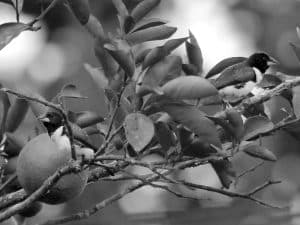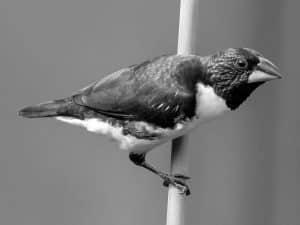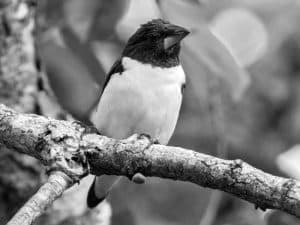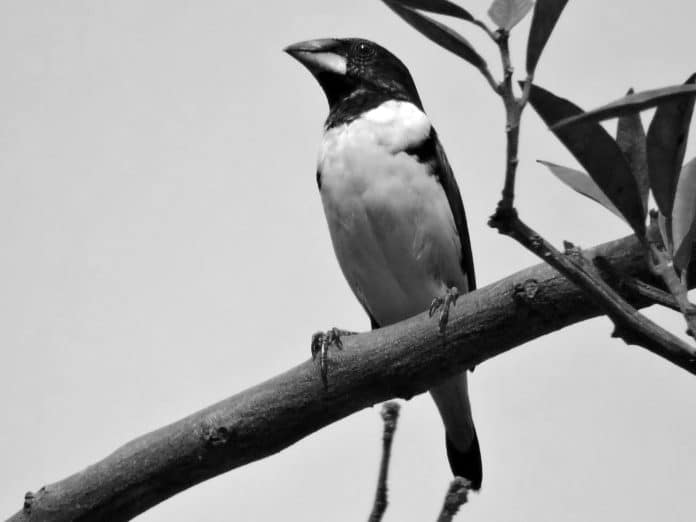Introduction to the Magpie Mannikin
Nestled within the vast expanse of Tanzania’s captivating wilderness lies a true avian gem – the enigmatic Magpie Mannikin. This diminutive yet striking bird is a true delight for birdwatchers and nature enthusiasts alike, offering a glimpse into the diverse and vibrant ecosystem that thrives in this East African nation. As you embark on your journey through Tanzania’s wildlife paradise, prepare to be enchanted by the Magpie Mannikin in Tanzania with its mesmerizing presence and uncover the secrets of its fascinating world.
Habitat and Distribution of the Magpie Mannikin in Tanzania

The Magpie Mannikin, scientifically known as Lonchura fringilloides, is a resident species found primarily in the central and southern regions of Tanzania. Its preferred habitat includes a diverse range of environments, from dense woodland and scrubland to open savannas and grasslands. These versatile birds have adapted to thrive in the varied landscapes that characterize Tanzania’s wildlife-rich territories.
- Central Tanzania: The Magpie Mannikin is commonly sighted in the central regions of Tanzania, particularly within the boundaries of iconic national parks such as Mikumi and Ruaha. These protected areas offer the perfect blend of habitats, providing the Magpie Mannikin with ample foraging opportunities and nesting sites.
- Southern Tanzania: Venture further south, and you’ll discover the Magpie Mannikin’s stronghold in the Selous Game Reserve, one of the largest and most untouched wilderness areas in Africa. This UNESCO World Heritage Site is a haven for the Magpie Mannikin, where it thrives amidst the diverse array of flora and fauna.
- Coastal Regions: While the Magpie Mannikin is primarily found in the central and southern regions of Tanzania, its distribution also extends to the coastal areas, particularly along the Tanzanian Riviera, where it can be spotted in coastal scrublands and mangrove forests.
Physical Characteristics and Behavior of the Magpie Mannikin
The Magpie Mannikin is a small, compact bird that measures approximately 12-14 centimeters in length. Its distinctive plumage features a striking combination of black, white, and chestnut hues, earning it the “magpie” moniker. The bird’s black head, white cheeks, and chestnut-colored back and wings create a visually captivating appearance that is sure to capture your attention.
In terms of behavior, the Magpie Mannikin is a highly social species, often seen foraging and nesting in small flocks. These birds exhibit a lively and energetic demeanor, flitting from one perch to another with graceful agility. Their melodious calls, a series of high-pitched chirps and trills, add to the enchanting soundscape of Tanzania’s wildlife havens.
Conservation Status of the Magpie Mannikin in Tanzania
The Magpie Mannikin is classified as a Least Concern species by the International Union for Conservation of Nature (IUCN), indicating that its global population is relatively stable. However, like many other avian species, the Magpie Mannikin faces various threats to its long-term survival in Tanzania.
- Habitat Loss: The expansion of agricultural activities, urbanization, and deforestation pose significant challenges to the Magpie Mannikin’s preferred habitats. Preserving the natural ecosystems that support this species is crucial for its continued existence in Tanzania.
- Illegal Wildlife Trade: The Magpie Mannikin, with its striking appearance, is sometimes targeted by the illegal wildlife trade, which can have detrimental effects on local populations. Strengthening conservation efforts and enforcement measures is essential to combat this threat.
- Climate Change: The impacts of climate change, such as changing rainfall patterns and temperature fluctuations, can also affect the Magpie Mannikin’s breeding and foraging patterns, potentially leading to population declines if not addressed.
Best Locations to Spot the Magpie Mannikin in Tanzania

Tanzania’s diverse national parks and game reserves offer numerous opportunities to catch a glimpse of the elusive Magpie Mannikin. Here are some of the best locations to add this captivating bird to your Tanzania wildlife checklist:
- Mikumi National Park: Situated in the heart of central Tanzania, Mikumi National Park is home to a thriving population of Magpie Mannikins. The park’s varied habitats, including open savannas and wooded areas, provide the perfect environment for these birds to thrive.
- Ruaha National Park: Venture to the southern region of Tanzania and explore Ruaha National Park, where the Magpie Mannikin can be found in abundance. The park’s diverse landscapes, from rolling hills to riverine forests, create a haven for this species.
- Selous Game Reserve: As one of the largest protected areas in Africa, the Selous Game Reserve is a prime destination for spotting the Magpie Mannikin. This UNESCO World Heritage Site boasts a rich avian diversity, including the elusive Magpie Mannikin.
- Coastal Regions: For a unique experience, keep an eye out for the Magpie Mannikin in the coastal regions of Tanzania, particularly in areas with a mix of scrubland and mangrove forests.
Tips for Birdwatching and Photographing the Magpie Mannikin
Capturing the Magpie Mannikin on camera or simply observing it in its natural habitat can be a truly rewarding experience. Here are some tips to enhance your birdwatching and photography endeavors:
- Timing is Key: The Magpie Mannikin is most active during the early morning and late afternoon hours, so plan your outings accordingly to increase your chances of spotting these birds.
- Patience and Stealth: Approach the Magpie Mannikin’s preferred habitats quietly and patiently. These birds are often skittish, so move slowly and avoid sudden movements to avoid startling them.
- Utilize Camouflage: Blend in with your surroundings by wearing neutral-colored clothing and using natural camouflage to your advantage. This will help you get closer to the Magpie Mannikin without being detected.
- Bring the Right Gear: Equip yourself with a high-quality pair of binoculars and a camera with a telephoto lens to capture the intricate details of the Magpie Mannikin’s plumage and behavior.
- Learn their Calls: Familiarize yourself with the Magpie Mannikin’s distinctive calls and vocalizations. This will aid in locating and identifying these birds in the field.
Other Bird Species Found in the Same Habitat as the Magpie Mannikin
The Magpie Mannikin’s preferred habitats in Tanzania are home to a diverse array of avian species, each contributing to the richness and vibrancy of the local ecosystems. As you explore the areas where the Magpie Mannikin resides, keep an eye out for the following feathered companions:
- Superb Starling: A stunning iridescent bird with a striking blue and purple plumage, often seen foraging alongside the Magpie Mannikin.
- Yellow-billed Hornbill: The distinctive large beak and striking black-and-white plumage of this iconic species make it a must-see for any avid birdwatcher.
- Lilac-breasted Roller: Known for its vibrant blue, purple, and green hues, this bird is a true delight to observe in flight.
- White-headed Vulture: A majestic raptor that soars high above the savannas, keeping a watchful eye on the Magpie Mannikin’s habitat.
- Helmeted Guineafowl: A ground-dwelling bird with a distinctive black-and-white patterned plumage, often seen in large flocks.
Ecotourism Opportunities in Tanzania’s Wildlife Paradise
Tanzania’s wildlife-rich landscapes offer an unparalleled ecotourism experience, catering to the needs of nature enthusiasts, birdwatchers, and conservation-minded travelers. By exploring the habitats of the Magpie Mannikin and other captivating species, you can contribute to the preservation of these remarkable ecosystems.
- Guided Birdwatching Tours: Embark on specialized birdwatching tours led by knowledgeable local guides who can help you spot the Magpie Mannikin and other avian wonders.
- Responsible Wildlife Safaris: Opt for eco-friendly safari experiences that prioritize the well-being of the animals and their habitats, ensuring a sustainable and ethical approach to wildlife viewing.
- Community-based Tourism: Support local communities by engaging in community-based tourism initiatives that provide economic opportunities and empower residents to protect their natural resources.
- Volunteer Opportunities: Explore volunteer programs that allow you to actively participate in conservation efforts, such as habitat restoration, wildlife monitoring, and environmental education.
Conservation Efforts and Organizations Supporting the Magpie Mannikin

The Magpie Mannikin’s long-term survival in Tanzania is dependent on the collective efforts of conservation organizations, government agencies, and local communities. Here are some of the key players working to protect this enigmatic species:
- Tanzania National Parks (TANAPA): The national park authority plays a crucial role in safeguarding the Magpie Mannikin’s habitats within Tanzania’s protected areas.
- Wildlife Conservation Society (WCS): This international NGO collaborates with local partners to conduct research, implement conservation strategies, and raise awareness about the Magpie Mannikin and other threatened species.
- BirdLife International: As a global partnership of conservation organizations, BirdLife International works to identify, monitor, and protect Important Bird and Biodiversity Areas (IBAs), which include the Magpie Mannikin’s key habitats.
- Tanzania Bird Atlas: This citizen science initiative engages local and international birdwatchers to collect valuable data on the distribution and population trends of Tanzania’s avian species, including the Magpie Mannikin.
To contribute to the conservation of the Magpie Mannikin and Tanzania’s rich biodiversity, consider supporting the efforts of these organizations through donations, volunteering, or participating in their ecotourism initiatives. Your involvement can make a lasting impact on the protection and appreciation of this enigmatic bird and its captivating habitat.
Conclusion: Encouraging the Protection and Appreciation of the Magpie Mannikin in Tanzania
The Magpie Mannikin is a true jewel in the crown of Tanzania’s wildlife paradise, captivating the hearts and minds of all who are fortunate enough to catch a glimpse of its enchanting presence. By exploring the habitats of this enigmatic bird, you not only have the opportunity to witness its unique beauty but also contribute to the ongoing efforts to protect and conserve this remarkable species.
As you venture through Tanzania’s diverse landscapes, remember to tread lightly, observe with reverence, and share your experiences to inspire others to appreciate the wonders of the Magpie Mannikin and the broader ecosystem it calls home. Together, we can ensure that this captivating bird continues to thrive in Tanzania’s wildlife paradise for generations to come.

































